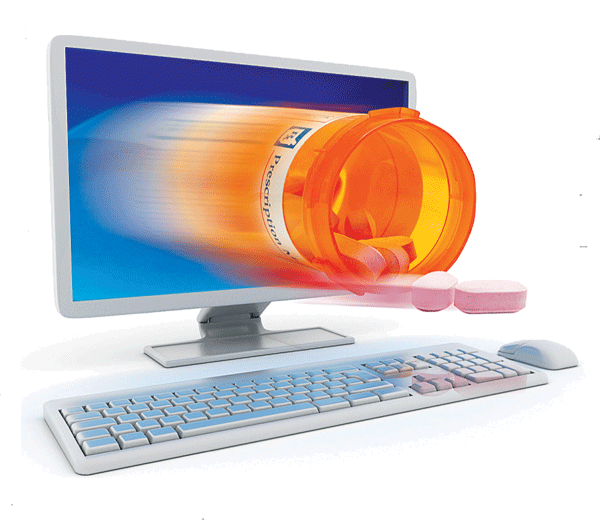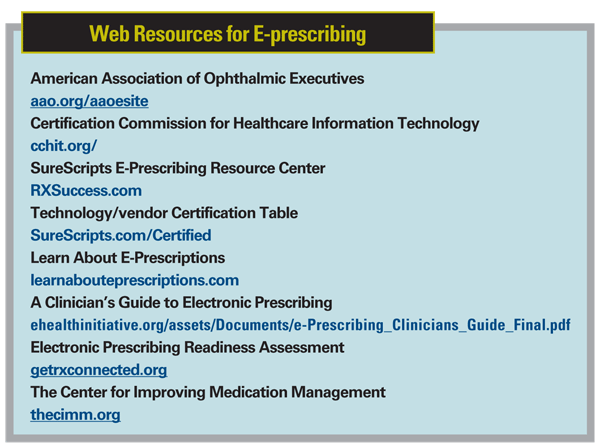Since her practice went to e-pre-scribing at the end of 2008, Cynthia Mattox, MD, has given up the pre-printed pads she used for writing glaucoma prescriptions. "E-prescribing does take a little longer than filling out the pre-printed pads," she says, but she maintains the advantages of e-prescribing outweigh the drawbacks.
Six months into Medicare's grand e-prescribing experiment, Dr. Mattox and others are learning much about e-prescribing: that the promised efficiencies require extensive up-front work; that completing an electronic script can actually take longer than handwriting one; that protecting patient privacy can be a challenge; and that pharmacies don't necessarily deliver instantaneous prescriptions. Dr. Mattox still will not go back to pen and pad—a prudent approach because Medicare is going to dock reimbursements to e-prescribing-phobic practitioners in three years.
Among the host of paradigm shifts shaping the future of medical practice, e-prescribing may be a model for how government affects change in health care and the gauge for how physicians will weather that change. If the sum of host of paradigm shifts is a medical tsunami, then e-prescribing may be the calm before the storm. This second installment of the on-going series describing how you can prepare for this maelstrom focuses on e-prescribing.
Ophthalmology and E-prescribing
Today about two in three ophthalmology practices either are using e-prescribing systems and working out the glitches, or plan to participate by year-end. About three of four pharmacies are on the e-prescribing network.
If ophthalmology were getting a grade for e-prescribing, it would find itself at the head of the class. Among the member societies in the e-prescribing resource getrxconnected.org, the
An AAOE survey in January showed that 63 percent of re-spondents plan to have a functioning e-prescribing system by year-end. About 16 percent said they would do e-prescribing via an electronic health record system; the remainder said they would use a freestanding e-prescribing program.
Maybe yours is one of those ophthalmology practices on the bubble, or maybe you've taken the plunge into e-prescribing but are worried you won't meet the Medicare mandate of 50 percent compliance to qualify for the bonus payment. This article looks at how ophthalmologists are dealing with the challenges e-prescribing has posed.
The First Steps
Getting the right e-prescribing system to match your practice's needs is critical. Dr. Mattox led the implementation of e-prescribing at
"The advantage of this particular program was that it could be used in handheld devices and did not need to be linked to a desktop or an established electronic medical records system," Dr. Mattox says. "We have lot of different satellite offices, so the advantage that it could be used on a handheld was important to us."
E-prescribing software comes in two varieties: systems that link into an existing electronic medical record system; and standalone software devoted solely to writing prescriptions. Many of the latter are available at no charge or can cost up to $2,500.
Many private payers provide additional incentives. "I don't think many physicians realize that many of these systems are free," says Donna McCune, a consultant and vice president with Corcoran Consulting Group. "Their existing management computer system may already have an e-prescribing module and they don't know it exists."
Some practices have electronic medical records systems already programmed for e-prescribing, which can be utilized with little additional cost. Others are opting to add-on a software package, many of which come at no-charge—but they also come with a catch.
"Most of the time it means it's not integrated with the practice management system, meaning that demographics are not coming over to the e-prescribing system," says Ms. Lock at the AAOE. So most practices she has heard from have office staff re-key in the names, addresses, insurance, etc., rather than pay a vendor to execute the transfer.
In Dr. Mattox's practice, loading that demographic data was the next step after she selected a standalone system. "Most of these vendors can do that," she says. "They link to your billing system or scheduling system, set up software interlinks and download your existing patients into the system."
The Certification Commission for Healthcare Information Technology recently unveiled a certification program for standalone e-prescribing software.
The Workflow Change-up
E-prescribing will change your office workflow. Once the demographics load into the software, your staff has to get from each patient his or her preferred pharmacy. "The key for the ophthalmology practice is to work that information into the patient intake process," says Robert Tennant, senior policy advisor at Medical Group Management Association. His suggestion: Notify patients before their office visit to bring the address of their pharmacy. SureScripts, the national e-prescribing database, contains a list of all participating pharmacies, but having the address beforehand saves staff time.
E-prescribing also involves training your office staff to handle electronic refills. "Refills will start coming in electronically, someone needs to check daily and then set the prescription up so that it's available for the doctor to review," Dr. Mattox says. "Once the prescription is already primed, so to speak, the doctor reviews it and then puts in her password and sends it to the pharmacy." The physician is key; he or she must be logged in to the system to activate each prescription.

Delegating this task is fraught with medicolegal pitfalls. "If the staff member types in the wrong information, the liability would rest with the physician," Ms. McCune says.
E-prescribing does not mean farewell to paper. Says Mr. Tennant: "That has been a problem for some doctors, and that's due to a number of reasons: By law you're not permitted to e-prescribe controlled substances; the second is the patient can still request the prescription on paper; and the third is the patient is either a visitor and doesn't have a drug store nearby or he's travelling and needs to bring the prescription along with him."
So initially, e-prescribing may not save time writing scripts. "But once the system is populated with the medications then I trust that it will be faster, and once the staff, the doctors and the technicians are more accustomed to e-prescribing, that's all going to improve," Ms. Lock says.
"In reality they can write a prescription faster than they can put it in a computer," Ms. McCune says. "The ease of doing it quickly is something that is keeping some doctors back, because they want to get onto to seeing the next patient, they don't want to have to go to the computer system." Handheld devices can solve this for some doctors. "The only problem is that unless they're really adept with the Blackberry, it's cumbersome to type all that stuff in," she says.
Glitches at the Pharmacy
An eye-opener for some physicians has been what pharmacies do with the prescription once they get it: They wait. "The reality is the pharmacy is very unlikely to fill that prescription until the patient arrives, for two reasons," Mr. Tennant says. "One is the patient may never arrive and never come to pick up the prescription; but the other one is more practical. When you go to pick up a prescription, typically the pharmacist tells the patient it will take about 10 to 15 minutes, so what do you do for 10 or 15 minutes? You shop." Not even e-prescribing can get retail pharmacies to change their business model.
E-prescribing has encountered another glitch on the pharmacy end: The patient goes to the pharmacy counter only to learn that no one has logged onto the e-prescribing system to download new prescriptions for some time. "When you ask the pharmacists, they'll tell you they only get 2 percent or 5 percent of their prescriptions that way so they don't check it that often," Mr. Tennant says. One way around that: Inform your local pharmacies you've adopted e-prescribing.
Other glitches revolve around network connections and outdated formulary data. "In some cases the concern is that health plans don't update their formularies as regularly as they could, or that they're not participating with a particular one anymore," Mr. Tennant adds. So what looks like a formulary drug in the doctor's office could be off formulary in the pharmacy.
Glitches in the Doctor's Office
A common glitch on the practice end involves reporting the Category III code with the office visit claim submission. "The issue is making sure Category III codes are consistently added to claims so that the practice has a chance of being eligible for the 2 percent Medicare bonus," Ms. Lock says. Some practices have a sheet they attach to the chart, and after each visit the technician must check one of three codes that summarize prescription activity during the patient visit. (See "Medicare's E-prescribing Bonus Program Explained," April 2009.)
The Health Insurance Portability and Accountability Act has thrown another curveball to e-prescribing ophthalmologists. "That's another consideration why some of those we suspect who were not prescribing in January are just starting e-prescribing now," Ms. Lock says. "You need to make sure your vendor is HIPAA-compliant."
At one of Ms. McCune's management seminars, a practice manager shared his concerns about patient privacy and e-prescribing. "He used his own name in their computer system to show someone how to use it, and he said up popped all the medications he had been prescribed," she says. "From a confidentiality standpoint, patients may not want the doctor to know everything they're taking. If it happens to be your doctor's wife's friend who comes in, she may not want you to know." Two employees in this practice asked to have their information deleted from the system.

Getting to the Payoff
The efficiencies of e-prescribing accrue to the overall practice. E-prescribing systems can instantaneously check if a prescribed drug is on a patient's health plan formulary. The systems also have a function called "fill status notification," which alerts the prescriber when a patient fails to fill a prescription. Dr. Mattox finds this function helpful in managing her glaucoma patients. Another added benefit to e-prescribing: "If you've sent a prescription to the pharmacy, if the patient doesn't call or arrange to pick it up in a certain time, the pharmacy is likely to call the patient to remind him," she says.
Mr. Tennant says e-prescribing can cut down the number of calls from the pharmacy to verify prescriptions. "To automate that process you can achieve pretty significant efficiencies," he says. "One of our studies suggested that pharmacy calls alone can cost a practice as much $10,000 per physician annually in administrative overhead."
More legible prescriptions are one of the efficiencies that sold
The MGMA estimates the average e-prescribing bonus payment from Medicare will be $600 next year. That may seem meager, but those who forego e-prescribing could be facing significant disincentives. In 2012 Medicare will incrementally reduce reimbursements to non-adopters, but then bump that cut to a full 2 percent in 2014. "In reality the biggest bang for their buck is this year and next year; the bonus is 2 percent, and it will drop after that," Ms. McCune says.




